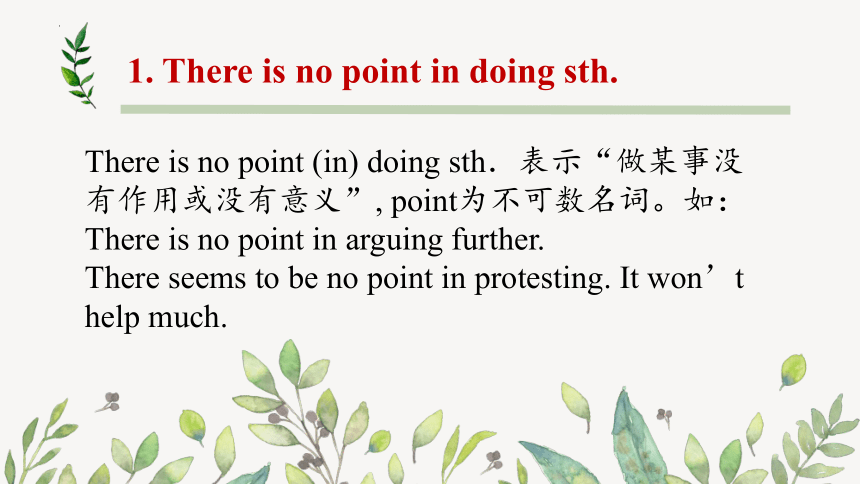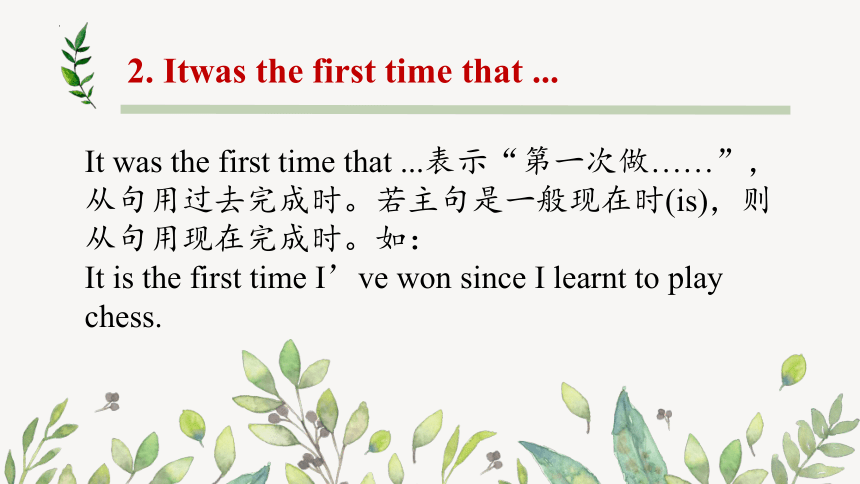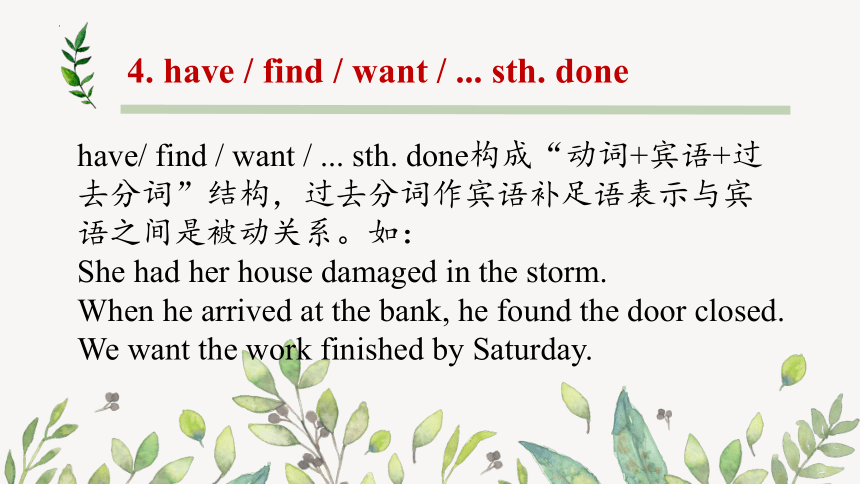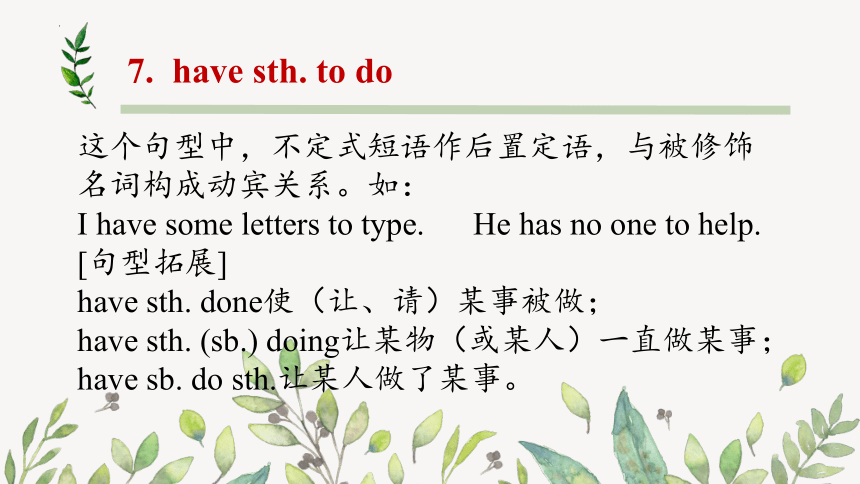2023届高三英语二轮复习重点句型归纳课件(25张PPT)
文档属性
| 名称 | 2023届高三英语二轮复习重点句型归纳课件(25张PPT) |

|
|
| 格式 | zip | ||
| 文件大小 | 905.2KB | ||
| 资源类型 | 教案 | ||
| 版本资源 | 通用版 | ||
| 科目 | 英语 | ||
| 更新时间 | 2023-01-01 20:19:28 | ||
图片预览









文档简介
(共25张PPT)
高中英语重点句型归纳
1. There is no point in doing sth.
There is no point (in) doing sth.表示“做某事没有作用或没有意义”, point为不可数名词。如:
There is no point in arguing further.
There seems to be no point in protesting. It won’t help much.
2. Itwas the first time that ...
It was the first time that ...表示“第一次做……”,从句用过去完成时。若主句是一般现在时(is),则从句用现在完成时。如:
It is the first time I’ve won since I learnt to play chess.
3. 形容词或形容词短语作状语
英语中形容词或形容词短语可作状语,说明主语行为的原因、方式、结果、伴随状况等。如:
Ripe, the oranges taste sweet. Coldand hungry, he decided to stop and have a rest.
After his journey from abroad, Richard Jones returned home, _______. (上海)
exhausted
4. have / find / want / ... sth. done
have/ find / want / ... sth. done构成“动词+宾语+过去分词”结构,过去分词作宾语补足语表示与宾语之间是被动关系。如:
She had her house damaged in the storm.
When he arrived at the bank, he found the door closed.
We want the work finished by Saturday.
5. A is to B what C is to D
A is to B what C is to D是个固定句型,意为“A对B而言正如C对D一样”。如:
Air is to us what water is to fish.
Reading is to the mind what food is to the body.
6. 形容词+动词不定式
“形容词+动词不定式”构成特殊结构,特点是不定式与其前面的作主语的名词或代词可构成逻辑动宾关系,该不定式通常需用主动形式表示被动意义。如:
This question is easy to answer.
The water in the river is not fit to drink.
[知识拓展]
若不定式是不及物动词,后加适当的介词或副词。The problem is easy to work out.
This room looks very comfortable to live in.
7. have sth. to do
这个句型中,不定式短语作后置定语,与被修饰名词构成动宾关系。如:
I have some letters to type. He has no one to help.
[句型拓展]
have sth. done使(让、请)某事被做;
have sth. (sb.) doing让某物(或某人)一直做某事;have sb. do sth.让某人做了某事。
8. I wish that ...
wish后接宾语从句,从句谓语动词要用虚拟语气:与过去事实相反,从句用过去完成时;与现在事实相反,从句用一般过去时;与将来事实相反,从句用could/would/might+动词原形。如:
He wished he hadn’t done it.
I wish we had a car.
I wish (that) you would get a good job.
9. Were/Had/Should ...
Were I in school again,I would work harder.
Had you been here earlier, you would have seen him.
10. on/upon (doing) sth. “一……就……”
On(my) asking for informationI was told I must wait.
On his return from Canada, he set to work.
[知识拓展]
“一……就”的其他表达方法:as soon as,the moment/minute, immediately, hardly ... when, no sooner ... than等。
11. more ... than ...“与其说……不如说……”
He is more diligent than clever.
The modern wide-bodied jetliner is very large. Inside, it looks more like a great theatre than (like) a plane.
12. It is one thing to ..., anther to ...
“……是一回事,……是另一回事”
It is one thing for you to write to him, another to telephone him.
It is one thing for you to stay here, another for me to ask you to stay here.
13. There is a good chance that ...
It’s likely that ...,表示“很可能……”
There is a good chance that you will catch up with your classmates.
There is little chance that the sick child will get well.
14. As sb. puts it ...
as sb. puts it ... 是固定句型,表示“正如某人所说”。如:
As the President puts it, “We have no choice but to develop our education, orwe’ll fall behind.”
As he puts it in the report, “Education is to be given to children by the government.”
15. Sb./Sth. is believed to be/have done ...
Sb./Sth. is believed to be/have done表示“被认为是……/已经做了某事”。know, say, expect, report, suppose等动词均能用于该句型。如:
She is believed to be the first to come up with this idea.
The company was reported to have invented a new type of car.
16. be up to sth.
be up to sth.表示“正在干,从事于(尤指坏事);在捣鬼;(体力或智力上)能胜任”。如:
He is up to no good.
What have you been up to lately
He’s not up to the job.
[知识拓展]
be up to sb.表示“是某人负责;由某人决定”,常用it作形式主语,用动词不定式作真正的主语。如: It’snot up to you to tell me how to do my job.
17. 动词-ing形式作主语
动词-ing形式作主语,多表示一个泛指的、抽象的动作;相对来说,动词不定式作主语,常表示特定的、具体的动作。如:
Seeing is believing.
To lean out of the car’s window is dangerous.
[知识拓展]
有时可用it作形式主语,而把动词-ing结构放在句末,用于“It is nouse/no good doing sth.”之类的句型。
It is no good waiting here. Let’s walk home.
18. There is no need to do sth.
There is no need to do sth.表示“(客观上)没有必要做某事”。如:
There’s no need for you to get up early tomorrow.
19. where引导的地点状语从句
地点状语从句一般由where和wherever引导。如:
Put the books where we can all see it.
Wherever you go, you will find computers being widely used.
[知识拓展]
where还可以引导定语从句。究竟如何区别where引导的是定语从句还是地点状语从句呢?
如果where前面有先行词,则where引导的是定语从句,否则where引导的是地点状语从句。另外,引导定语从句的关系副词where在从句中充当状语,可由“介词+which”代替,而地点状语从句通常只能由连接副词where引导。如:
After the war, a new school building was put up where there hadonce been a theatre.
She moved to Paris where she lived for five years.
20. be + of + 抽象名词
一般用来表示人或事物的性质或特征。of后常接value, use, help, importance,difference等抽象名词。而且在这些名词前也可以用 little, some, any, no, great等词修饰。of 后还可以接age, color, size, height, opinion等名词表示类属。但名词前通常加不定冠词或the same.
例如:His words is of no use.
The twocars are of the same color.
21. the + 形容词/ 副词比较级,the +形容词/ 副词比较级
表示"越 … 就越 …"表示一个方面的程度随着另一方面的程度平行增进或递减。
例如:The more you eat, the fatteryou'll be.
22. not/ no/ never/ nothing +比较级
表示 "没有…比…更" 即比较级表达最高级概念。
例如:There is nothing more interestingthan the film I have ever seen in the past years.
23. 比较级+ than any other + 单数可数名词
表示最高级概念。也可以表达为 " 比较级 + than any other + 名词复数/the others" 或 "比较级+ than anyone( anybody) else"但是,如果比较的对象不在同一个范围之内,则用 " 比较级 + any + 单数名词"
例如:He works harder than any otherstudents in his class.
China islarger than any country in Africa.
感谢观看
高中英语重点句型归纳
1. There is no point in doing sth.
There is no point (in) doing sth.表示“做某事没有作用或没有意义”, point为不可数名词。如:
There is no point in arguing further.
There seems to be no point in protesting. It won’t help much.
2. Itwas the first time that ...
It was the first time that ...表示“第一次做……”,从句用过去完成时。若主句是一般现在时(is),则从句用现在完成时。如:
It is the first time I’ve won since I learnt to play chess.
3. 形容词或形容词短语作状语
英语中形容词或形容词短语可作状语,说明主语行为的原因、方式、结果、伴随状况等。如:
Ripe, the oranges taste sweet. Coldand hungry, he decided to stop and have a rest.
After his journey from abroad, Richard Jones returned home, _______. (上海)
exhausted
4. have / find / want / ... sth. done
have/ find / want / ... sth. done构成“动词+宾语+过去分词”结构,过去分词作宾语补足语表示与宾语之间是被动关系。如:
She had her house damaged in the storm.
When he arrived at the bank, he found the door closed.
We want the work finished by Saturday.
5. A is to B what C is to D
A is to B what C is to D是个固定句型,意为“A对B而言正如C对D一样”。如:
Air is to us what water is to fish.
Reading is to the mind what food is to the body.
6. 形容词+动词不定式
“形容词+动词不定式”构成特殊结构,特点是不定式与其前面的作主语的名词或代词可构成逻辑动宾关系,该不定式通常需用主动形式表示被动意义。如:
This question is easy to answer.
The water in the river is not fit to drink.
[知识拓展]
若不定式是不及物动词,后加适当的介词或副词。The problem is easy to work out.
This room looks very comfortable to live in.
7. have sth. to do
这个句型中,不定式短语作后置定语,与被修饰名词构成动宾关系。如:
I have some letters to type. He has no one to help.
[句型拓展]
have sth. done使(让、请)某事被做;
have sth. (sb.) doing让某物(或某人)一直做某事;have sb. do sth.让某人做了某事。
8. I wish that ...
wish后接宾语从句,从句谓语动词要用虚拟语气:与过去事实相反,从句用过去完成时;与现在事实相反,从句用一般过去时;与将来事实相反,从句用could/would/might+动词原形。如:
He wished he hadn’t done it.
I wish we had a car.
I wish (that) you would get a good job.
9. Were/Had/Should ...
Were I in school again,I would work harder.
Had you been here earlier, you would have seen him.
10. on/upon (doing) sth. “一……就……”
On(my) asking for informationI was told I must wait.
On his return from Canada, he set to work.
[知识拓展]
“一……就”的其他表达方法:as soon as,the moment/minute, immediately, hardly ... when, no sooner ... than等。
11. more ... than ...“与其说……不如说……”
He is more diligent than clever.
The modern wide-bodied jetliner is very large. Inside, it looks more like a great theatre than (like) a plane.
12. It is one thing to ..., anther to ...
“……是一回事,……是另一回事”
It is one thing for you to write to him, another to telephone him.
It is one thing for you to stay here, another for me to ask you to stay here.
13. There is a good chance that ...
It’s likely that ...,表示“很可能……”
There is a good chance that you will catch up with your classmates.
There is little chance that the sick child will get well.
14. As sb. puts it ...
as sb. puts it ... 是固定句型,表示“正如某人所说”。如:
As the President puts it, “We have no choice but to develop our education, orwe’ll fall behind.”
As he puts it in the report, “Education is to be given to children by the government.”
15. Sb./Sth. is believed to be/have done ...
Sb./Sth. is believed to be/have done表示“被认为是……/已经做了某事”。know, say, expect, report, suppose等动词均能用于该句型。如:
She is believed to be the first to come up with this idea.
The company was reported to have invented a new type of car.
16. be up to sth.
be up to sth.表示“正在干,从事于(尤指坏事);在捣鬼;(体力或智力上)能胜任”。如:
He is up to no good.
What have you been up to lately
He’s not up to the job.
[知识拓展]
be up to sb.表示“是某人负责;由某人决定”,常用it作形式主语,用动词不定式作真正的主语。如: It’snot up to you to tell me how to do my job.
17. 动词-ing形式作主语
动词-ing形式作主语,多表示一个泛指的、抽象的动作;相对来说,动词不定式作主语,常表示特定的、具体的动作。如:
Seeing is believing.
To lean out of the car’s window is dangerous.
[知识拓展]
有时可用it作形式主语,而把动词-ing结构放在句末,用于“It is nouse/no good doing sth.”之类的句型。
It is no good waiting here. Let’s walk home.
18. There is no need to do sth.
There is no need to do sth.表示“(客观上)没有必要做某事”。如:
There’s no need for you to get up early tomorrow.
19. where引导的地点状语从句
地点状语从句一般由where和wherever引导。如:
Put the books where we can all see it.
Wherever you go, you will find computers being widely used.
[知识拓展]
where还可以引导定语从句。究竟如何区别where引导的是定语从句还是地点状语从句呢?
如果where前面有先行词,则where引导的是定语从句,否则where引导的是地点状语从句。另外,引导定语从句的关系副词where在从句中充当状语,可由“介词+which”代替,而地点状语从句通常只能由连接副词where引导。如:
After the war, a new school building was put up where there hadonce been a theatre.
She moved to Paris where she lived for five years.
20. be + of + 抽象名词
一般用来表示人或事物的性质或特征。of后常接value, use, help, importance,difference等抽象名词。而且在这些名词前也可以用 little, some, any, no, great等词修饰。of 后还可以接age, color, size, height, opinion等名词表示类属。但名词前通常加不定冠词或the same.
例如:His words is of no use.
The twocars are of the same color.
21. the + 形容词/ 副词比较级,the +形容词/ 副词比较级
表示"越 … 就越 …"表示一个方面的程度随着另一方面的程度平行增进或递减。
例如:The more you eat, the fatteryou'll be.
22. not/ no/ never/ nothing +比较级
表示 "没有…比…更" 即比较级表达最高级概念。
例如:There is nothing more interestingthan the film I have ever seen in the past years.
23. 比较级+ than any other + 单数可数名词
表示最高级概念。也可以表达为 " 比较级 + than any other + 名词复数/the others" 或 "比较级+ than anyone( anybody) else"但是,如果比较的对象不在同一个范围之内,则用 " 比较级 + any + 单数名词"
例如:He works harder than any otherstudents in his class.
China islarger than any country in Africa.
感谢观看
